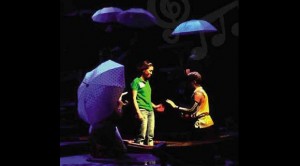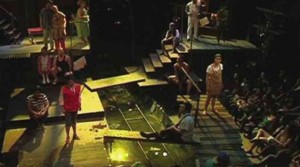
Myke Salomon is able to break apart Celso Abenoja’s compositions for seminal rock band Aegis into fun and sometimes funny new arrangements in Philippine Educational Theater Association’s “Rak of Aegis,” which is running at Peta Theater Center until March 9.
His rearrangements, like a slower mix of “Halik,” lets the lyrics and melodies’ emotions flow in ways that rend the heart from new trajectories, but definitely no less potent than Aegis’ familiar all-out wailing, face-melting renditions. His electronic dance music piece that samples the same song is light and catchy.
It’s more pun in the Philippines with the production’s title, a play on the title of the Broadway musical “Rock of Ages,” and its setting in perpetually flooded Barangay Venizia, a takeoff from canal-lined Venice.
With book by Liza Magtoto (adding a few lyric changes here and there) and directed by Peta artistic director Maribel Legarda, this jukebox musical comes after Tanghalang Pilipino’s “EJ: Ang Pinagdaanang Buhay nina Evelio Javier at Edgar Jopson” (The Dawn) in 2008 and Culture Shock Productions’ “Sa Wakas” (Sugarfree) last year. (Magtoto has an unproduced, unstaged draft of a jukebox musical using the discography of the Eraserheads.)
Timely commentary
The musical shows audiences its characters’ struggles with the elusive nature of happiness, offering a timely commentary on what it has meant to be a Filipino in the first few years of the 2010s: hoping against hope amidst the ubiquity of technology (that not all Filipinos have access to, much less utilize) and of calamities (the musical was created post-“Ondoy,” pre-“Yolanda”).
No matter how advanced the technologies available to them (i.e., the global reach of the Internet) and no matter how severe the disasters that have inundated them (meteorological, ecological, economic, and, of course, most importantly, romantic), the characters’ ongoing concerns are still to seek out what will make them happy.
At least, what they think will make them happy—love or money (by way of a job or fame) or both.
Aileen wants to be famous so she can help her family. Kenny and Tolits both want Aileen. Aileen’s father Kiel needs to keep his job. Kiel’s employer Mary Jane needs to keep her business afloat.
Technical feat

Mio Infante’s set design is a technical feat, with a strip of thigh-high floodwater right down the middle (which gets rained on, too). Dressed with floating detritus, the water looks absolutely disgusting and looks/feels like it smells bad, too.
Slightly confusing, though, is the lack of submerged infrastructure, making the flooded eskinita look more like an estero that had always been there (a banca too stately to be a makeshift raft reinforces this notion). Suspended miniature houses as a backdrop that were perhaps meant to create a false perspective of urban sprawl instead create a weird sense of upward scale: Is Barangay Venizia on a hill?
The ensemble sings well (musical direction is also by Salomon) and their blended voices sound solid. They’re dressed in threads that feel very now and very real, with a touch of gaudy Pinoy sensibility, designed by John Pagunaling.
Joan Bugcat delivers on the vocal acrobatics required of Aileen. Both Bugcat and Salomon (Kenny) execute their roles with an appealing vibe that speaks of their characters’ youthful naivete and whiny brashness.
Juliene Mendoza (Kiel) and Kalila Aguilos (Mary Jane) draw from what seems to be bottomless reservoirs of emotion. Mendoza imbues his songs with tender sincerity and anguished longing, while Aguilos informs hers with an edgy weariness.
Pepe Herrera (Tolits) is the surprise shining star of this production. He steals the show completely with his singing prowess and comic timing.
Redundant
The production feels bloated because of a tendency to be redundant. It begins with an overture medley and ends Act 1 with a medley reprise. Several songs are repeated, the novelty of their new contexts wearing off with each refrain. The dialogue is didactic and constantly repeats facts, justifications, reasons and explanations.
One song that was repeated was worth it, though—the entertaining baritone-soprano rendition of “Sinta” by Ron Alfonso (as enterprising sari-sari store owner Jewel), sans doble-kara makeup and costume.
Like the debris bobbing up and down the floodwaters of the set, the flow of the musical suffers from fits and starts, partly due to the way songs are cut and the way scenes are ended and sometimes due to slow scene changes and belabored audience participation segments.
Aileen losing her job comes a little late and out of nowhere in Act 1. Perhaps it might have added to the despair and created a sense of urgency if it happened earlier? It feels forced, as if the collaborators needed an excuse to be able to include “Christmas Bonus” into the musical.
Bubbly duet
Strange also is the fact that while Kenny and his mother have a make-up conversation, the same opportunity is not given to Aileen and her father.
Lighting design and blocking sometimes did not swim together, resulting in audiences straining to search for who was talking.
There is no way to miss, however, a cheer-inducing, bubbly duet between Aileen and Tolits backed by a chorus of labanderas with magic wands.
Note: Most roles are played by sets of alternating actors. The alternates are Aicelle Santos for Aileen, Isay Alvarez-Seña for Mary Jane, Robert Seña for Kiel, Poppert Bernadas for Kenny, Jerald Napoles for Tolits and Phi Palmos for Jewel.
“Rak of Aegis” runs until March 9 at Peta-Phinma Theater, Peta Theater Center, 5 Eymard Drive, New Manila, Quezon City (behind Quezon City Sports Club). Contact 7256244, 0917-5765400; or e-mail [email protected]. Tickets also available through Ticketworld at 8919999 or ticketworld.com.ph.













































